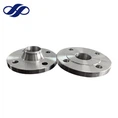National standard flange, refers to the flange piece produced according to the provisions of the National Standard of the People's Republic of China "GB/T 9112~9124-2010 steel pipe flange".
National standard flange standard was jointly issued by the General Administration of Quality Supervision, Inspection and Quarantine of the People's Republic of China and the National Standardization Administration of China on 2011-01-10 and has been a recommended standard implemented since 2011-10-01 [7] .
GB/T 9112~9124-2010 includes a total of 13 standards as follows.
Replaces the national standard GB/T 9112-2000; GB/T 10745-1989 standard
GB/T 9112-2010 Steel pipe flanges Types and parameters
GB/T 9113-2010 Integral steel pipe flanges
GB/T 9114-2010 Steel pipe flange with neck thread
GB/T 9115-2010 Butt-welded steel pipe flanges
GB/T 9116-2010 Flat-welded steel pipe flange with neck
GB/T 9117-2010 Necked socket welded steel pipe flanges
GB/T 9118-2010 Butt-welded ring necked loose-fitting steel pipe flange
GB/T 9119-2010 Plate flat welding steel pipe flange
GB/T 9120-2010 Butt-welded ring plate type loose-fitting steel pipe flange
GB/T 9121-2010 Flat welded ring plate type loose-fitting steel pipe flange
GB/T 9122-2010 Flanged ring plate type loose-fitting steel pipe flange
GB/T 9123-2010 Steel pipe flange cover
GB/T 9124-2010 Steel pipe flange
Technical conditions
The pressure markings specified in this standard are divided into PN markings and Class markings.
PN mark has 12 pressure levels
PN2.5; PN6; PN10; PN16; PN25; PN40; PN63; PN100; PN160; PN250; PN320; PN400, respectively
Class mark has 6 pressure classes
respectively: Class 150; Class 300; Class 600; Class 900; Class 1500; Class 2500
Another layer of the national standard flange meaning: in accordance with the national standard requirements of the size, tolerance range, etc. production flange, distinguished from the standard size of the production of flange pieces also known as two standard flange (someone called non-standard flange is incorrect), usually some unscrupulous businessmen will reduce the flange thickness, outer diameter of the two dimensions to achieve the purpose of saving materials, and scrap steel or scrap steel processing flange, usually this steel Is the chemical composition and mechanical properties of the scrap does not meet the standard, and even more with the black steel mill private steel production flange, this private steel using the old steelmaking technology can not guarantee the mechanical properties and welding properties, the use of steel may not be able to weld with the steel pipe, or the steel itself has cracks, porosity, etc. After welding up will also leak, so try to choose the national standard flange when buying a flange. If the funds are limited to choose the second standard flange must be carefully observed and measured flange size to avoid being fooled.
Processing professional equipment
Processing and manufacturing of large diameter flange to have professional equipment to do half the work, professional equipment, such as CNC disc milling machine, large head lathe.
Common faults
In the modern industrial continuous production flange by the medium corrosion, scouring, temperature, pressure, vibration and other factors, will inevitably appear leakage problems. Due to the error of the sealing surface processing size, the aging of sealing components and improper installation and fastening and other reasons are very easy to cause the flange leakage. If the flange leakage problem can not be timely management, in the washout of the medium will make leakage rapidly expand, resulting in material loss, damage to the production environment, resulting in enterprise downtime, resulting in huge economic losses. If it is toxic and harmful, flammable and explosive media leakage, and may cause poisoning, fire and explosion and other major accidents.
The traditional solution for flange leakage is to replace the sealing components and apply sealant or replace the flange and piping, but the method has great limitations, and some leakage is restricted by the requirements of the safety of the working environment, can not be solved on site. Now it is possible to use polymer composite materials for on-site plugging, of which the application is more mature with the system of Fushi Blue. It is a very ideal method, especially in flammable and explosive occasions, but also to show its unique superiority. The construction process of polymer composite material technology is simple, safe and low cost, which can solve most of the flange leakage problems for enterprises, eliminate safety hazards and save more maintenance costs for enterprises.
Scope of application
Because the flange has good comprehensive performance, so it is widely used in chemical industry, construction, water supply, drainage, petroleum, light and heavy industry, refrigeration, sanitation, plumbing, fire-fighting, electric power, aerospace, shipbuilding and other basic projects.





